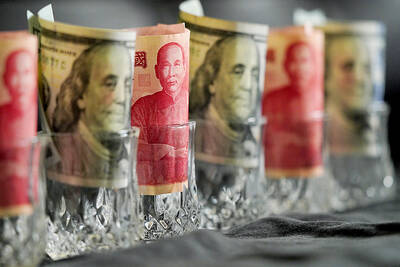Ritek Corp (
"Our first-half profit will be less than half that of a year ago," Daniel Yao (
His forecasts signal profit of about NT$700 million (US$21 million) in the first half and NT$1.9 billion in the second. The company's ability to deliver depends on how much competition in its bread-and-butter CD business suppresses prices and on how quickly the company can lower production costs in its new flat-panel display business.
Ritek's entry in the DVD disc market comes as Japanese manufacturers of home movie players are phasing out videotape systems in favor of players that can air a full Hollywood blockbuster from a single disc. Prices of DVD players have dropped to as little at US$80, putting them within reach of more consumers.
"Recordable discs are a fast-moving industry," said Mark Mobius, who manages about NT$4 billion he manages in Asia for Templeton Asset Management Ltd. "Recordable DVDs are expanding at a very rapid pace."
Indeed, Ritek expects sales of the digital video discs to account for 10 percent of revenue this year, surging from less than 1 percent last year. That's good news for a company that makes a 50 gross margin on each sale. By contrast, margins on blank compact discs almost disappeared in the last year as more rivals entered the business, Yao said. A blank disc sells for as little as US$0.23 in Hong Kong.
He said Ritek will ship about 80 percent of this year's production of DVD discs during the second half. He said he expects profit margins to rise to as high as 30 percent in its mainline CD business. Persistent competition from the likes of CMC Magnetics Corp (
Ritek isn't counting on DVD discs alone to reverse poor profit. It's also developing its flat-panel display business, with investment from Intel Corp, DuPont Co and General Electric Co.
"We expect sales of the displays this year to be worth NT$20 million to NT$30 million," Yao said. ``Next year, sales will be over NT$100 million.''
That may rank Ritek second to Japan's Pioneer Corp in world production of a new Eastman Kodak Co technology -- called organic light-emitting diode technology -- to be used in dashboard displays, cellphones and hand-held electronics.
"There's going to be terrific competition," Mobius said. "The jury's still out on that. The key is how fast they get mass production up and running and bring down production costs."
Yao said the company shipped its first displays to an unidentified cell-phone maker in Taiwan that supplies handsets to American and European customers. By the end of this year, the display unit will add two production lines to one already in operation. One of the lines will make full-color screens and the other will use DuPont know-how called poly-organic light-emitting diode technology, which produces brighter and thinner panels than those sued in notebook computers.
Yao said Ritek will spend as much as NT$200 million this year on expansion of disc and flat-panel businesses.

The US dollar was trading at NT$29.7 at 10am today on the Taipei Foreign Exchange, as the New Taiwan dollar gained NT$1.364 from the previous close last week. The NT dollar continued to rise today, after surging 3.07 percent on Friday. After opening at NT$30.91, the NT dollar gained more than NT$1 in just 15 minutes, briefly passing the NT$30 mark. Before the US Department of the Treasury's semi-annual currency report came out, expectations that the NT dollar would keep rising were already building. The NT dollar on Friday closed at NT$31.064, up by NT$0.953 — a 3.07 percent single-day gain. Today,

‘SHORT TERM’: The local currency would likely remain strong in the near term, driven by anticipated US trade pressure, capital inflows and expectations of a US Fed rate cut The US dollar is expected to fall below NT$30 in the near term, as traders anticipate increased pressure from Washington for Taiwan to allow the New Taiwan dollar to appreciate, Cathay United Bank (國泰世華銀行) chief economist Lin Chi-chao (林啟超) said. Following a sharp drop in the greenback against the NT dollar on Friday, Lin told the Central News Agency that the local currency is likely to remain strong in the short term, driven in part by market psychology surrounding anticipated US policy pressure. On Friday, the US dollar fell NT$0.953, or 3.07 percent, closing at NT$31.064 — its lowest level since Jan.

The New Taiwan dollar and Taiwanese stocks surged on signs that trade tensions between the world’s top two economies might start easing and as US tech earnings boosted the outlook of the nation’s semiconductor exports. The NT dollar strengthened as much as 3.8 percent versus the US dollar to 30.815, the biggest intraday gain since January 2011, closing at NT$31.064. The benchmark TAIEX jumped 2.73 percent to outperform the region’s equity gauges. Outlook for global trade improved after China said it is assessing possible trade talks with the US, providing a boost for the nation’s currency and shares. As the NT dollar

PRESSURE EXPECTED: The appreciation of the NT dollar reflected expectations that Washington would press Taiwan to boost its currency against the US dollar, dealers said Taiwan’s export-oriented semiconductor and auto part manufacturers are expecting their margins to be affected by large foreign exchange losses as the New Taiwan dollar continued to appreciate sharply against the US dollar yesterday. Among major semiconductor manufacturers, ASE Technology Holding Co (日月光), the world’s largest integrated circuit (IC) packaging and testing services provider, said that whenever the NT dollar rises NT$1 against the greenback, its gross margin is cut by about 1.5 percent. The NT dollar traded as strong as NT$29.59 per US dollar before trimming gains to close NT$0.919, or 2.96 percent, higher at NT$30.145 yesterday in Taipei trading